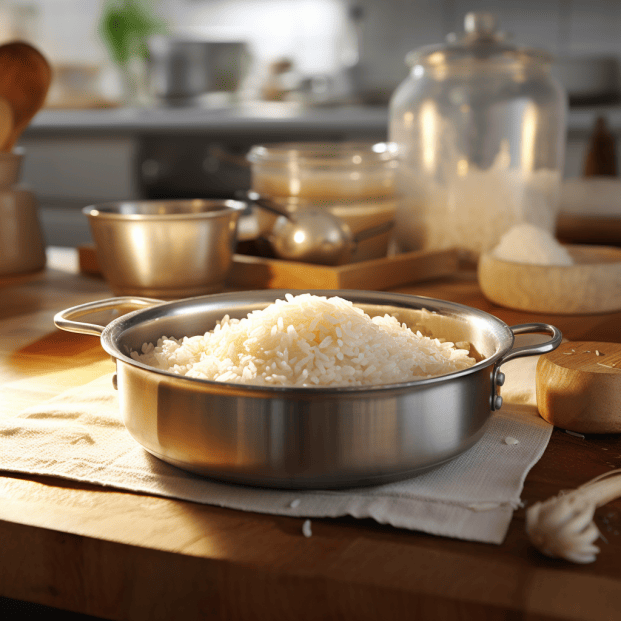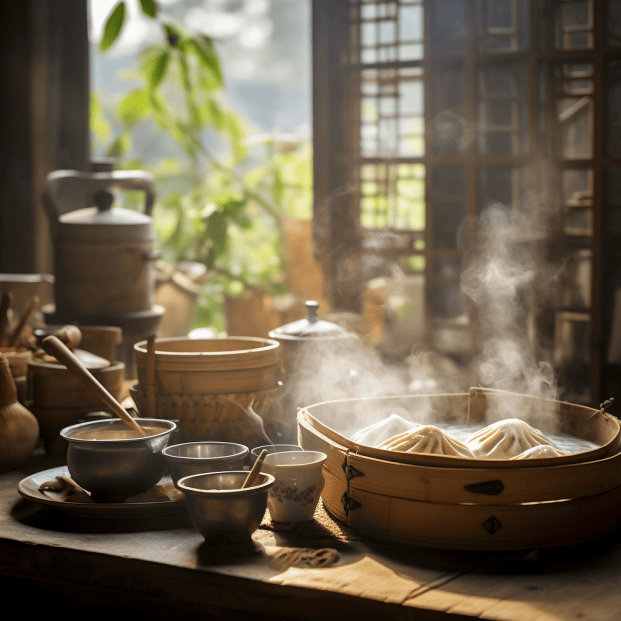I absolutely adore the taste of rice in Chinese restaurants.
It’s always so fluffy and super satisfying! Have you ever asked yourself how they cook it so perfectly?
How rice is cooked in Chinese restaurants?
As someone who loves noshing nearly as much studying cuisine, I been wondering for years the secret behind restaurant rice.
Turns out there’s more to it than just boil and serve! Through chin-wagging with chefs and doing my own experiments in the kitchen, I learned heaps of insider hacking.
Now I’m ready to spill the grains – that’s right, I said spill the grains.
Ba-dum-tish! This rice whisperer is here to blab all the tips and tricks.
Like didja know they don’t actually steam or fry their rice? It’s all a trick with movie magic and jelly beans – oops, I think I said too much!
Whether you’re a hungry traveler or food nerd like myself, this guide got what you crave.
By the end, you’ll be throwing rice dances of your own like those Iron Chef pros.
Just keeps scrolling for secret ingredients, shockin techniques and more jokes!
Your taste buds will be glad you decided to kick it with me and learn the tricks behind terrific takeaway rice.
The real magic starts right after these three knock-knock jokes…
KEY TAKEAWAY
How rice is cooked in Chinese restaurants?
In Chinese restaurants, rice is often cooked using traditional methods like stir-frying in a wok for a smoky flavor or steaming for a light and fluffy texture (1), showcasing the culinary expertise that goes into each dish.
What Rice Varieties Do Chinese Restaurants Use for Steamed Rice?
When chowing down at Chinese eateries, they often use short, plump rice grains for steaming their sides.
Picking the perfect rice is key to the flavor and texture hitting the spot.
Short grain means stickiness and absorbing flavors greatly, making it top-notch for steaming.
Restaurant chefs know the rice quality sets the whole meal’s taste.
Steamed rice holds down many Chinese dishes from stir-fries to soups.
It should feel a touch chewy with each grain soft and firm.
Many go for varieties like Jasmine or sushi rice.
Their shorter, rounder form differs from long, skinny rice in other cuisine.
These traits allow keeping moisture in when cooking while staying separate and intact.
As we uncover how the cooking wizards prep their grains, it’s important to first clean them correctly.
Let’s see what pros do before tossing rice into pots…
How Do Chinese Chefs Wash and Rinse Rice Before Cooking?

To rinse rice properly ahead of heating, chefs begin by putting grains in a bowl and swashing with water.
This step removes extra starch or dirt which may cling on. (2)
As a restaurant whiz, I delicately ensure each grain gets entirely scrubbed before cooking.
First pour water over rice and gently swirl fingers to release anything stuck.
After a few seconds, drain water out carefully without losing rice.
Repeat twice more with fresh water, letting it sit for a couple minutes each time before swirling and pouring.
Doing this guarantees only pristine grains for your meal.
Following the final rinse, experts drain excess water but leave enough dampness on grains.
This allows them to steam perfectly without becoming too soggy.
Their techniques create the best rice around, fluffy and delicious each time!
What Tools and Cookware are Ideal for Making Fluffy Restaurant Rice

Fluffy, separated grains achieved at restaurants require using high-quality cookware tailored for the job.
A rice cooker contains even heating elements and precise temperature controls for foolproof results.
Modern rice cooker models from reputable brands feature durable, professional-grade construction.
This allows for perfectly distributed heat that consistently steams each grain to tender doneness without over-cooking.
Stove-top cooking with a heavy-bottomed pot is also effective when done properly.
Thick, conductive materials prevent hotspots and scorching on the bottom.
Meanwhile, a tight-fitting lid seals in ambient moisture essential for light, fluffy textures.
Prior to use, ensuring pots and pans are free of residue builds a foundation for success.
A quick scrub removes buildup that could compromise cooking.
Regular maintenance ensures tools live up to their investment.
With practice navigating different models and methods, home cooks can achieve quintessential rice just like top restaurants with minimal effort using the right appliances.
Quality equipment makes all the difference for perfect grains.
Do Chinese Restaurants Soak or Steam Rice – What’s the Method
Soaking is a primary step for restaurant excellence.
It softens grains for even doneness while removing excess starches to prevent clumping.
Rinsing until water runs clear fully prep grains.
Covering soaked rice in water for 30 minutes or longer fully hydrates each piece at its own rate.
Proper soaking varies by grain type but softens for successful results.
Steaming provides a gentle alternative heating method and allows for thorough water absorption prior to fluffing.
Bamboo steamers efficiently suspend rice for consistent cooking.
Transferring soaked rice to a heat-safe bowl above a shallow water layer in a steamer or rice cooker mimics classic technique.
Trapped steam circulates for light, airy grains.
With the right traditional preparations, home chefs can achieve prize-winning rice quality using basic tools found in any kitchen.
Proper soaking and steaming unlock grains’ full flavor and texture.
How Long Does it Take to Steam Rice to Perfect Doneness
When steamin’ rice to perfection in the kitchen, it’s important to pay attention to timing.
All types of rice, from jasmine to basmati, need the right amount of time in the pot to become tender but not soggy.
Generally, steamed rice finishes up in about 20 to 30 minutes.
Water ratio is also key – you’ll wanna use 1 to 1 1/2 cups H2O for each cup of rice.
Measure careful-like so the rice absorbs liquid evenly.
Rice grain type affects time too, as short grain jasmine takes less time than long grain brown.
Quantity cookin’ also adjusts the clock, so big batches may require extra minutes.
I start by rinsin’ rice in a colander under runnin’ tap water.
Swish it around with my hands till the water runs clear.
Then I add the rinsed rice and water to a pot.
After bringing it to a boil over a high flame, I reduce the heat and seal it up with a tight-fittin’ lid.
This traps the steam inside to gently cook the grains.
Lifting the lid too often will let out precious steam and won’t cook things through properly.
So I wait patient-like for at least 20 minutes till checkin’ for doneness.
When the rice is tender and separate, it’s done-zo! Fluff it up with a fork to keep grains from stickin’ together.
With accurate water and cook time, steamed rice turns out perfect every go.
What are the Secrets to Keeping Fried Rice Light and Not Greasy
The secret to light and not greasy fried rice lies in using cold cooked rice grains.
This preserves their shape during stir-fryin’ so the final dish stays fluffy and not packed down.
A few other tricks help achieve picture-perfect fried rice worthy of any Chinese restaurant.
Cookin’ over smokin’ hot heat means ingredients like veggies and protein won’t get soggy.
It also concentrates flavors for real yumminess.
Adding lots of chopped carrots, peas or peppers boosts the nutrition too.
Wait till almost done to toss in soy sauce – its deep flavor gets distributed real good that way.
Overcrowdin’ the wok is no good either.
Things will just steam up instead of fryin’ crispy.
Work in batches for best results.
With these easy techniques, you can make delicious fried rice just as light and delicious as the pros anytime cravin’s strike!
Proper prep and wok work make all the difference for a dish that’s light on the tastebuds and stomach.
How Should You Store and Reheat Leftover Rice to Maintain Quality?
When storing and reheating leftover rice, it’s important to follow proper food safety guidelines to ensure its quality remains intact.
After enjoying a delicious rice recipe, I often find myself with leftover cold rice that needs to be stored properly.
One key factor in maintaining the quality of reheated rice is managing the excess starch.
Cold rice tends to clump together due to the starch content, resulting in a less appealing texture when reheated.
To store leftover rice, I transfer it into an airtight container and place it in the refrigerator as soon as possible.
This helps prevent bacterial growth and keeps the rice fresh for up to four days.
When reheating, I prefer using a microwave or stovetop method rather than the oven.
By adding a small amount of water or broth before heating, I can loosen up the clumps and restore some moisture.
If I want to incorporate my leftover rice into stir-fried vegetables or other dishes, I make sure to break up any remaining clumps by gently separating them with my fingers before adding them to the pan.
This ensures even distribution of heat and prevents any unpleasant surprises while eating.
Conclusion
As I reflect on the process of cooking rice in Chinese restaurants, I am fascinated by the attention to detail and skill involved.
From the selection of rice varieties to the careful washing and rinsing, every step is crucial in achieving that fluffy texture we all love.
The artistry lies not only in the method of soaking or steaming but also in knowing how long to cook it for that perfect doneness.
And when it comes to fried rice, the secret is keeping it light and not greasy.
Overall, this culinary journey has shown me that cooking rice is truly an art form – a delicate dance between technique and taste, resulting in a harmonious symphony on our plates.
References
- https://www.eatingchina.com/recipes/white-rice.htm
- https://www.cookingmanager.com/rice-washed-cooking/
Related Articles
- https://bowlakechinese.com/steaming/
- https://bowlakechinese.com/do-chinese-wash-rice-before-cooking/
- https://bowlakechinese.com/is-it-better-to-boil-rice-or-steam-it/
Was this helpful?

I am a skilled chef assistant with a passion for Asian cuisine, I have honed my craft through formal training at At-Sunrice GlobalChef Academy and years of experience in the culinary industry. I have extensive knowledge of cooking techniques and herbs and spices, with a particular focus on traditional Chinese dishes. I’m also an author of the book “Delicious Keto Low Carb Chinese Food for Busy Moms and Fitness Enthusiasts” which is sold on Amazon. On my blog, bowlakechinese.com, I share my expertise in Asian cuisine and provide tips and recipes for those interested in low carb Chinese cuisine.

